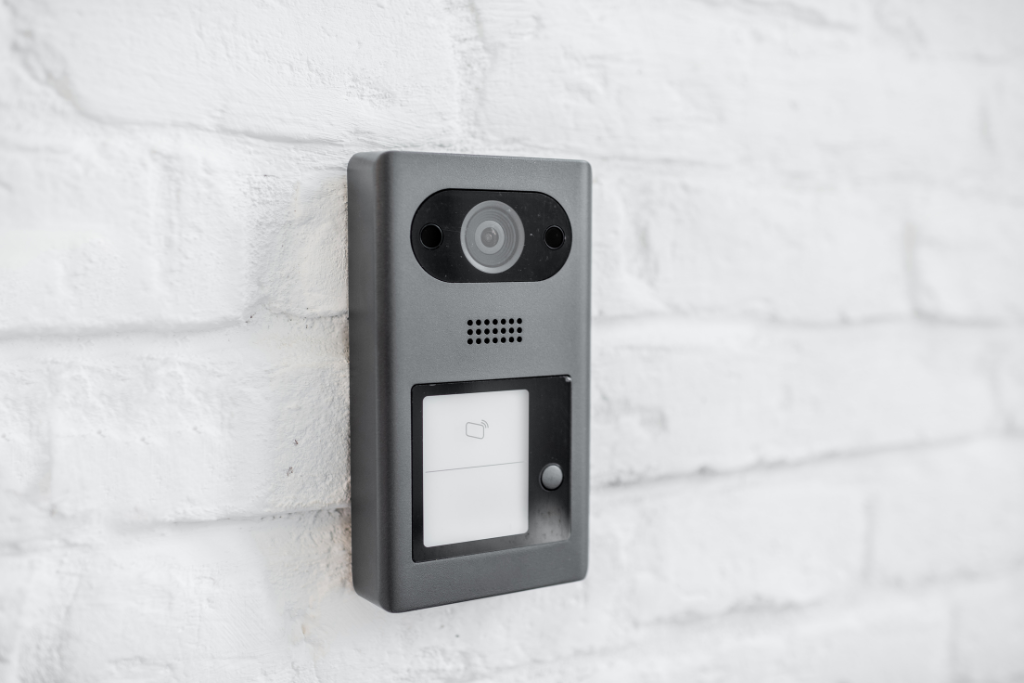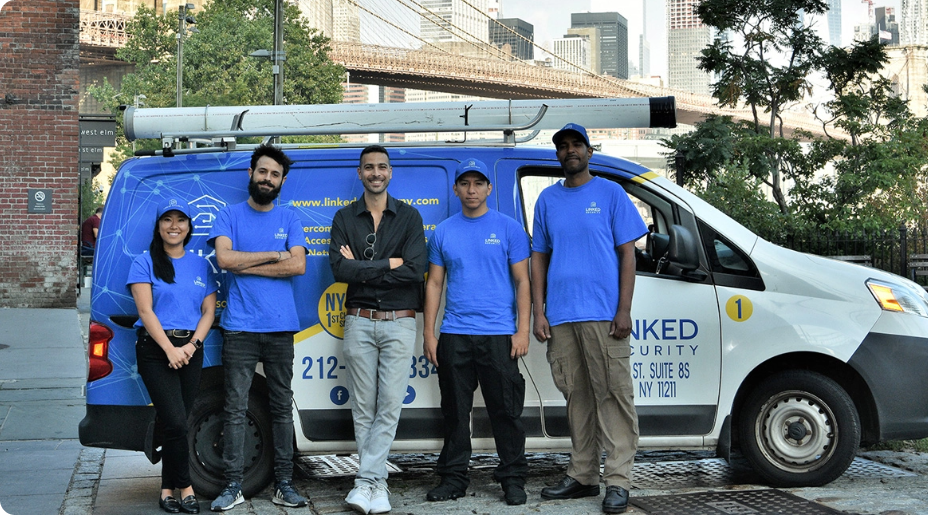Top Home Intercom Systems 2023 – Ultimate Guide

Did you know that home intercom systems are revolutionizing the way we communicate within our homes? These communication devices provide a secure and efficient way to connect between different rooms or areas, ensuring easy and convenient communication for homeowners like yourself. But here’s the shocking part: according to recent studies, over 70% of households still rely on outdated methods of communication within their homes, such as shouting or using handheld devices.
That’s where home intercom systems come in. Available in various types, including wired and wireless options, these systems not only enhance convenience but also bolster home security. Imagine being able to screen visitors at your entrance before granting access with just a push of a button! These innovative systems can be seamlessly integrated with other smart home devices, allowing you to control everything from lighting to temperature without leaving your seat.
So why settle for outdated communication methods when modern technology offers a smarter solution? Whether you’re looking to upgrade your current system or considering installing one for the first time, we’ve got you covered!
Great! The introduction is complete. It includes a shocking statistic or fact about the usage of home intercom systems and highlights the convenience and security they offer. It also emphasizes the integration with other smart home devices. The introduction sets up the tone for the rest of the blog post by capturing readers’ attention and piquing their curiosity about home intercom systems.
Wired vs Wireless Home Intercom Systems
Wired Systems: Reliable Connection with Complex Installation
One of the key considerations is whether to opt for a wired or wireless system. Let’s start by exploring the advantages and characteristics of wired systems.
Wired systems are known for their reliable connection, offering a stable and uninterrupted means of communication within your home. These systems require physical wiring installation, ensuring a secure connection that is not vulnerable to interference from external factors like radio signals or Wi-Fi congestion.
However, it’s important to note that setting up a wired system can be more complex compared to wireless alternatives. Due to the intricate wiring needs, professional installation may be necessary. This helps ensure that all components are properly connected and functioning optimally. While this adds an extra cost upfront, it guarantees that your wired intercom system will perform reliably over the long term.
Wireless Systems: Flexibility in Installation with DIY Setup
On the other hand, wireless home intercom systems offer greater flexibility. These systems utilize radio signals or Wi-Fi technology to establish communication between different units within your home. Without the need for physical wires, you have more freedom in deciding where you want your intercom units placed.
Setting up a wireless system is generally easier compared to wired alternatives since there is no need for extensive wiring work. In fact, many wireless intercom systems can be set up as do-it-yourself (DIY) projects. With simple instructions provided by manufacturers, you can easily install and configure these systems without professional assistance.
While wireless systems provide convenience and ease of installation, they may not offer the same level of reliability as their wired counterparts. Factors such as distance from the main unit or potential interference from other electronic devices could affect signal strength and audio quality in certain situations.
Making Your Choice: Considerations and Trade-Offs
When deciding between wired and wireless home intercom systems, it’s important to consider your specific needs and priorities. Here are a few factors to keep in mind:
- Reliability: If having a consistently stable connection is crucial for your communication needs, a wired system might be the better option. Wired systems eliminate the risk of signal interference and provide a reliable means of communication throughout your home.
- Installation Convenience: Wireless systems offer more flexibility in terms of installation locations, allowing you to place units wherever they are most convenient for you. Their DIY setup makes them an attractive choice for those who prefer handling installation themselves.
- Cost Considerations: While wired systems may have higher upfront costs due to professional installation requirements, they often offer better long-term reliability. On the other hand, wireless systems tend to be more affordable initially but may require occasional maintenance or upgrades over time.
- Audio Quality: Wired systems generally provide better audio quality since they are not subject to potential interference from external factors like Wi-Fi congestion or radio signals.
Factors to Consider When Choosing a Home Intercom Systems
Assess the Size and Layout of Your Home
Before choosing a home intercom system, it’s essential to determine the size and layout of your home. This will help you assess the coverage needed for effective intercom communication. A larger home with multiple floors or rooms may require a more robust system that can transmit signals over longer distances. On the other hand, if you have a smaller apartment or single-level house, a simpler intercom system might suffice.
Consider how far apart different areas of your home are and whether there are any obstacles, such as walls or floors, that could affect signal strength. By understanding your home’s layout, you can choose an intercom system that provides reliable communication throughout your entire living space.
Determine the Number of Units Required
The number of units required for your home intercom system depends on how many rooms or areas you want to connect. Consider which rooms you would like to have intercom access to, such as bedrooms, living areas, or even outdoor spaces. Each area will require its own unit for seamless communication.
For example, if you have a three-bedroom house with a kitchen and living room, you would need at least five units—one for each bedroom and one for each common area. It’s also worth considering if you want additional units in specific locations like the garage or backyard.
By determining the number of units needed based on your desired connectivity, you can ensure that everyone in your household can easily communicate with one another no matter where they are in the house.
Evaluate Audio Quality and Range
When choosing a home intercom system, audio quality is crucial for clear communication between different areas of your home. You don’t want to struggle to hear what someone is saying or experience static-filled conversations.
Look for systems that offer high-quality audio transmission without distortion or interference. Some systems may provide options for adjusting volume levels to suit individual preferences. Consider the range of the intercom system. Ensure that it can cover the distance between important areas of your home without signal degradation.
By prioritizing audio quality and range, you can enjoy crystal-clear communication with your family members or housemates, enhancing convenience and safety within your home.
Additional Features to Consider
While intercom systems primarily serve as a means of communication, many modern options offer additional features that can enhance their functionality. Here are some extra features to consider when choosing a home intercom system:
- Video Monitoring: Some intercom systems come equipped with video capabilities, allowing you to see who is at your front door or monitor different areas of your home remotely. This feature adds an extra layer of security and convenience.
- Smartphone Integration: Look for systems that offer smartphone integration, enabling you to control and access your intercom system through a dedicated app on your mobile device. This feature allows for easy management even when you’re away from home.
- Voice Activation
Wireless Options for Home Intercom Systems
Wireless intercom systems have revolutionized the way we communicate within our homes. Gone are the days of extensive wiring work and complicated installations. With wireless intercom systems, setting up a reliable communication network throughout your home is as easy as pie.
One of the key advantages of wireless intercom systems is their effortless installation process. No need to deal with messy wires or drill holes in your walls. Simply find a suitable location for your intercom base station and connect it to a power source. That’s it! You’re ready to enjoy seamless communication between different areas of your home.
To ensure crystal clear audio transmission over longer distances, many wireless options utilize DECT (Digital Enhanced Cordless Telecommunications) technology. This advanced technology provides superior sound quality, making sure you never miss an important message or conversation. Whether you’re in the basement or out in the garden, rest assured that your wireless intercom system will keep you connected.
Interference from other devices can be a common issue when using wireless systems. However, by choosing a wireless intercom system that supports multiple channels or frequencies, you can avoid this problem altogether. These systems allow you to switch between different channels to find the one with minimal interference, ensuring uninterrupted communication within your home.
Let’s dive deeper into some popular options available for wireless intercom systems:
1. Piece Wireless Home Security System
This all-in-one solution combines security features with intercom functionality, providing peace of mind and convenience in one package. With built-in cameras, motion sensors, and door/window sensors, this system not only allows you to communicate with family members but also keeps an eye on your home’s security.
2. Outdoor Station
If you want to extend your communication network beyond the walls of your home, consider adding an outdoor station to your wireless intercom system setup. This weatherproof device allows visitors at your front door to communicate with you inside, enhancing security and convenience.
3. FM Radio Integration
Some wireless intercom systems come equipped with an integrated FM radio feature. This allows you to enjoy your favorite tunes or catch up on the latest news while going about your daily tasks at home. With the touch of a button, switch from intercom mode to radio mode and groove to your heart’s content.
Enhancing Security with Video Home Intercom Systems
In today’s fast-paced world, ensuring the safety and security of our homes is of utmost importance. With advancements in technology, video intercom systems have emerged as a valuable tool for enhancing home security. These innovative systems provide visual identification of visitors before granting access, offering homeowners peace of mind and control over who enters their premises.
Visual Identification for Added Security
One of the key benefits of video intercom systems is the ability to visually identify visitors before opening the door. Traditional doorbells only provide an audio interaction, leaving homeowners uncertain about who is on the other side. However, with video intercoms, you can see who is at your doorstep through a built-in camera. This visual confirmation allows you to make informed decisions about granting access and ensures that you are not caught off guard by unexpected or unwanted guests.
Motion Detection and Recording Capabilities
To further enhance home security, many video intercom systems come equipped with motion detection and recording capabilities. These features allow you to monitor any suspicious activity around your property even when you are away. By capturing footage whenever motion is detected, these systems act as a deterrent against potential intruders and provide valuable evidence in case of any untoward incidents.
Night Vision Functionality for Low-Light Conditions
Security concerns do not end when the sun goes down. That’s why it is crucial to choose a video intercom system with night vision functionality. Whether it’s poorly lit entryways or nighttime visits from friends or family, having clear visibility in low-light conditions ensures that you can always see who is approaching your home. Night vision cameras utilize infrared technology to capture detailed images even in complete darkness, providing an added layer of security.
Remote Monitoring and Control via Smartphone Apps
The integration of video intercom systems with smartphone apps has revolutionized home security. With just a few taps on your mobile phone screen, you can remotely monitor and control your video intercom system from anywhere. Whether you are at work, on vacation, or simply in another room of your house, these apps allow you to see live video feeds, receive notifications when someone is at the door, and even communicate with visitors through two-way audio calling. This level of convenience and control empowers homeowners to stay connected and take immediate action if necessary.
Easy Interaction with Two-Way Audio Communication
Gone are the days of shouting through closed doors or struggling to hear what visitors are saying outside. Video intercom systems with two-way audio communication enable easy interaction between homeowners and visitors. With a built-in speaker and microphone, these systems facilitate clear communication without the need for physical proximity. Whether it’s instructing a delivery person where to leave a package or having a conversation with friends at your doorstep, two-way audio ensures smooth and hassle-free interactions.
Making the Right Choice With Home Intercom Systems
Choosing the right intercom system for your home is an important decision that can greatly enhance your security and convenience. With so many options available in the market, it’s crucial to evaluate your specific needs before making a final choice. Consider factors such as the size of your home, desired features, and budget to ensure you find the perfect fit.
Evaluate Your Specific Needs
Start by assessing the size of your home and determining how many units you will need. If you have a large house with multiple floors or separate buildings on your property, you may require a more complex system that can cover all areas effectively. On the other hand, if you live in a smaller space, a simpler intercom system might suffice.
Think about where you want to install the intercom units within your home. Most commonly, homeowners choose to place them near their front doors for easy communication with visitors. However, depending on your requirements, you may also want units in other rooms or even outside buildings on your property.
Consider what features are essential for you. Do you want video capabilities so that you can see who is at your door? Are hands-free options important? Make a list of must-have features and prioritize them based on their importance to help guide your decision-making process.
Research Different Brands and Models
Once you have identified your specific needs, it’s time to research different brands and models of intercom systems for homes. Look for reliable and reputable options that have positive customer reviews and ratings.
Reading customer reviews is an excellent way to gather insights into performance, ease of use, and durability. Pay attention to any recurring issues or complaints mentioned by users as this could indicate potential drawbacks or limitations of certain models.
Consider seeking recommendations from friends or family members who already have intercom systems installed in their homes. They may be able to provide valuable firsthand experiences and help narrow down your choices.
Compare Prices and Retailers
Comparing prices from different retailers or online platforms is an essential step in finding the best deal for your intercom system. Take the time to browse various websites and check if any ongoing promotions or discounts are available.
While it’s tempting to opt for the cheapest option, remember that quality should also be a priority. Look for a balance between affordability and reliability. Sometimes investing a bit more upfront can save you money in the long run by ensuring durability and longevity.
Consider reaching out to local professionals or experts in home security systems. They can provide personalized recommendations based on your specific needs and budget. Their expertise can be invaluable in helping you make an informed decision.
Conclusion: Making the Right Choice for Your Home Intercom Systems
So there you have it, all the essential information you need to make an informed decision about your home intercom system. Whether you opt for a wired or wireless system, consider factors like range, audio quality, and ease of installation. Take a look at our top recommendations for 2023 and compare their features to find the perfect fit for your needs.
Now that you’re equipped with this knowledge, it’s time to take action! Upgrade your home security and communication by investing in a reliable intercom system. Don’t wait until it’s too late – ensure the safety of your loved ones and enjoy the convenience an intercom system brings. So go ahead, and choose the right intercom system for your home today!
FAQs About Home Intercom Systems
Can I install a home intercom systems myself?
Absolutely! Many home intercom systems are designed with easy installation in mind. With basic DIY skills and following the provided instructions, you can set up most systems without professional assistance.
Can I use a wireless home intercom systems in an apartment building?
Yes, wireless home intercom systems are ideal for apartment buildings as they don’t require complex wiring installations. However, be mindful of range limitations if you have multiple floors or thick walls.
Can I integrate my home intercom systems with other smart devices?
Certainly! Many modern home intercom systems offer integration with smart devices such as smartphones or voice assistants like Alexa or Google Assistant. This allows you to control and monitor your intercom system conveniently.
Are video intercom systems more secure than audio-only systems?
Video intercom systems provide an extra layer of security by allowing visual identification of visitors before granting access. This feature can enhance overall security compared to audio-only systems.
Do I need a power source near each unit in a wired home intercom system?
Yes, wired home intercom systems require power sources near each unit for proper functionality. Ensure that electrical outlets are available in the desired locations before installing a wired system.





